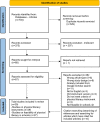Validity, Reliability, and Feasibility of Physical Literacy Assessments Designed for School Children: A Systematic Review
- PMID: 37341907
- PMCID: PMC10504218
- DOI: 10.1007/s40279-023-01867-4
Validity, Reliability, and Feasibility of Physical Literacy Assessments Designed for School Children: A Systematic Review
Abstract
Background: While the burgeoning researcher and practitioner interest in physical literacy has stimulated new assessment approaches, the optimal tool for assessment among school-aged children remains unclear.
Objective: The purpose of this review was to: (i) identify assessment instruments designed to measure physical literacy in school-aged children; (ii) map instruments to a holistic construct of physical literacy (as specified by the Australian Physical Literacy Framework); (iii) document the validity and reliability for these instruments; and (iv) assess the feasibility of these instruments for use in school environments.
Design: This systematic review (registered with PROSPERO on 21 August, 2022) was conducted in accordance with the Preferred Reporting Items for Systematic Review and Meta-Analysis (PRISMA) statement.
Data sources: Reviews of physical literacy assessments in the past 5 years (2017 +) were initially used to identify relevant assessments. Following that, a search (20 July, 2022) in six databases (CINAHL, ERIC, GlobalHealth, MEDLINE, PsycINFO, SPORTDiscus) was conducted for assessments that were missed/or published since publication of the reviews. Each step of screening involved evaluation from two authors, with any issues resolved through discussion with a third author. Nine instruments were identified from eight reviews. The database search identified 375 potential papers of which 67 full text papers were screened, resulting in 39 papers relevant to a physical literacy assessment.
Inclusion and exclusion criteria: Instruments were classified against the Australian Physical Literacy Framework and needed to have assessed at least three of the Australian Physical Literacy Framework domains (i.e., psychological, social, cognitive, and/or physical).
Analyses: Instruments were assessed for five aspects of validity (test content, response processes, internal structure, relations with other variables, and the consequences of testing). Feasibility in schools was documented according to time, space, equipment, training, and qualifications.
Results: Assessments with more validity/reliability evidence, according to age, were as follows: for children, the Physical Literacy in Children Questionnaire (PL-C Quest) and Passport for Life (PFL). For older children and adolescents, the Canadian Assessment for Physical Literacy (CAPL version 2). For adolescents, the Adolescent Physical Literacy Questionnaire (APLQ) and Portuguese Physical Literacy Assessment Questionnaire (PPLA-Q). Survey-based instruments were appraised to be the most feasible to administer in schools.
Conclusions: This review identified optimal physical literacy assessments for children and adolescents based on current validity and reliability data. Instrument validity for specific populations was a clear gap, particularly for children with disability. While survey-based instruments were deemed the most feasible for use in schools, a comprehensive assessment may arguably require objective measures for elements in the physical domain. If a physical literacy assessment in schools is to be performed by teachers, this may require linking physical literacy to the curriculum and developing teachers' skills to develop and assess children's physical literacy.
© 2023. The Author(s).
Conflict of interest statement
This review was supported by funding from the Australian Sports Commission. The Australian Sports Commission funded development of the Australian Physical Literacy Framework and the Physical Literacy for Children Questionnaire. Three authors of this review (LMB, DD, RK) were involved in development of the Australian Physical Literacy Framework and four authors on this review (LMB, RK, JS, DD) were involved in developing the Physical Literacy for Children Questionnaire.
Figures
Similar articles
-
Portuguese Physical Literacy Assessment Questionnaire (PPLA-Q) for adolescents (15-18 years) from grades 10-12: development, content validation and pilot testing.BMC Public Health. 2021 Nov 29;21(1):2183. doi: 10.1186/s12889-021-12230-5. BMC Public Health. 2021. PMID: 34844566 Free PMC article.
-
Beyond the black stump: rapid reviews of health research issues affecting regional, rural and remote Australia.Med J Aust. 2020 Dec;213 Suppl 11:S3-S32.e1. doi: 10.5694/mja2.50881. Med J Aust. 2020. PMID: 33314144
-
Assessments Related to the Physical, Affective and Cognitive Domains of Physical Literacy Amongst Children Aged 7-11.9 Years: A Systematic Review.Sports Med Open. 2021 May 27;7(1):37. doi: 10.1186/s40798-021-00324-8. Sports Med Open. 2021. PMID: 34046703 Free PMC article.
-
Effects of Holistically Conceptualised School-Based Interventions on Children's Physical Literacy, Physical Activity, and Other Outcomes: A Systematic Review.Sports Med Open. 2024 Sep 27;10(1):105. doi: 10.1186/s40798-024-00766-w. Sports Med Open. 2024. PMID: 39333343 Free PMC article.
-
Portuguese Physical Literacy Assessment Questionnaire (PPLA-Q) for Adolescents: Validity and Reliability of the Psychological and Social Modules using Mokken Scale Analysis.Percept Mot Skills. 2023 Jun;130(3):958-983. doi: 10.1177/00315125231159688. Epub 2023 Mar 2. Percept Mot Skills. 2023. PMID: 36861939 Free PMC article. Review.
Cited by
-
Relationship between physical literacy and mental health in adolescents: a moderated mediation model with resilience and physical activity as variables.Front Psychol. 2025 Feb 4;16:1518423. doi: 10.3389/fpsyg.2025.1518423. eCollection 2025. Front Psychol. 2025. PMID: 40008347 Free PMC article.
-
Validation of the PL-C Quest in China: understanding the pictorial physical literacy self-report scale.Front Psychol. 2024 Mar 7;15:1328549. doi: 10.3389/fpsyg.2024.1328549. eCollection 2024. Front Psychol. 2024. PMID: 38515980 Free PMC article.
-
Assessing physical literacy with school-aged children in occupational therapy practice: An exploratory qualitative study.Br J Occup Ther. 2024 May;87(5):290-301. doi: 10.1177/03080226231220566. Epub 2024 Jan 5. Br J Occup Ther. 2024. PMID: 40337537 Free PMC article.
-
Constructing and evaluating the physical literacy index for college students in China: a new insight and perspective.Front Public Health. 2025 Jun 23;13:1612356. doi: 10.3389/fpubh.2025.1612356. eCollection 2025. Front Public Health. 2025. PMID: 40626161 Free PMC article.
-
Development of a Global Physical Literacy (GloPL) Action Framework: Study protocol for a consensus process.PLoS One. 2024 Aug 12;19(8):e0307000. doi: 10.1371/journal.pone.0307000. eCollection 2024. PLoS One. 2024. PMID: 39133681 Free PMC article.
References
-
- Jurbala P. What is physical literacy, really? Quest. 2015;67(4):367–383. doi: 10.1080/00336297.2015.1084341. - DOI
-
- Shearer C, Goss H, Edwards L, Keegan RJ, Knowles ZR, Boddy LM, et al. How is physical literacy defined? A contemporary update. J Teach Phys Educ. 2018 doi: 10.1123/jtpe.2018-0136. - DOI
Publication types
MeSH terms
Grants and funding
LinkOut - more resources
Full Text Sources
Research Materials
Miscellaneous


